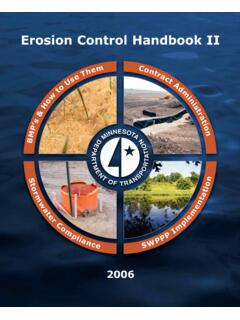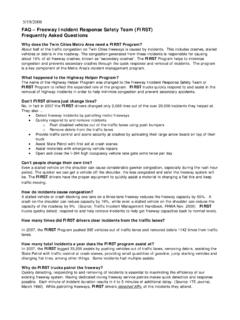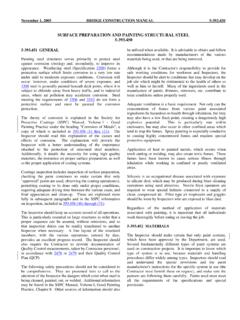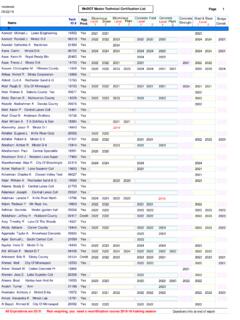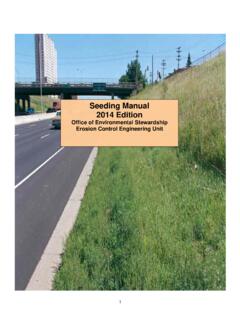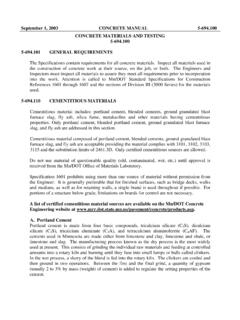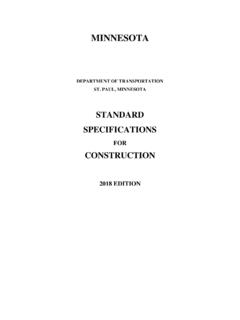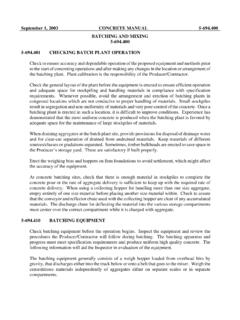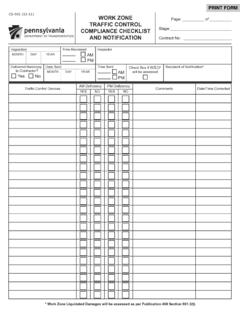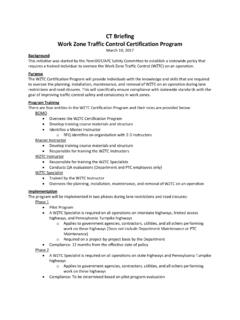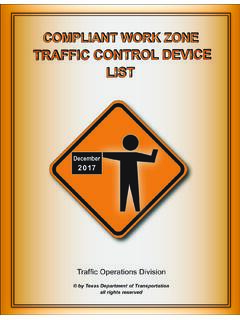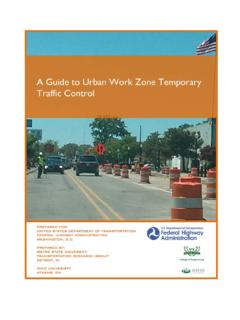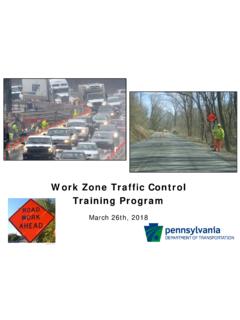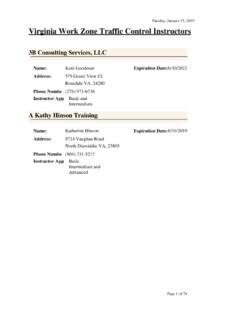Transcription of Chapter 8 WORK ZONE TRAFFIC CONTROLS - dot.state.mn.us
1 October 31, 2009 TRAFFIC ENGINEERING MANUAL8-1 Chapter 8 work ZONE TRAFFIC CONTROLSTABLE OF INTRODUCTION .. to Other Mn/DOT Standards and GLOSSARY .. RESPONSIBILITY .. PLANNING FOR TRAFFIC CONTROLS .. TRAFFIC control Management and Temporary TRAFFIC control TEMPORARY TRAFFIC control DEVICES .. Markings in Temporary TRAFFIC control Precast Concrete Barrier (PPCB) Mounted (centerline) Changeable Message Signs (PCMS) Arrow Cushions and Attenuators Joints and Edge TEMPORARY TRAFFIC control PLANS .. of Temporary TRAFFIC control control Devices TRAFFIC control Pay ESTABLISHING AND MAINTAINING DETOURS .. Requiring or Permitting a of a of a Maintenance work on of a DetourAugust 1, 2007 TRAFFIC ENGINEERING INSTALLATION AND INSPECTION OFTEMPORARY TRAFFIC control DEVICES .. REFERENCES .. TRAFFIC Management Plan DetoursList of A, B, and C Channelizers .. Construction Sign Panel Overlay Coveringa Complete Extruded Sign Panel.
2 Construction Sign Panel Overlay Coveringa Portion of an Extruded Sign Panel .. Construction Sign Panel Overlay CoveringType C or D Sign Panels ..8a-4 List of of Detour Form .. of Detour Form .. 1, 2007 TRAFFIC ENGINEERING PurposeThis Chapter is intended to show applications of basic principles of work zone TRAFFIC control and assist indeveloping TRAFFIC control ScopeThis Chapter has been written to supplement, not to replace, the MN MUTCD. This Chapter includes guidelinesvarying from planning TRAFFIC control to fit the needs of a particular activity to the reasons for keeping accuraterecords. These guidelines should be useful to any qualified individual involved with planning, designing,installing, maintaining, and inspecting TRAFFIC control in work zones . Individuals are qualified by means of adequatetraining in TRAFFIC control practices, having a basic understanding of the principles of TRAFFIC control in work zones ,or having experience in applying TRAFFIC control in work road authorities are encouraged to evaluate the MN MUTCD and establish guidelines to meet their Relation to other Mn/DOT Standards and GuidelinesAs stated, this Chapter is to supplement, not to replace, Part 6 Temporary TRAFFIC CONTROLS of of the latest editionof the MN MUTCD.
3 The MN MUTCD includes the Field Manual for Temporary TRAFFIC control Zone layouts andthe Standard Signs guidelines contained in this Chapter and in TRAFFIC control plans should conform to, or be of higher standardsthan, the MN MUTCD and other Mn/DOT technical standards and guidelines. Adequate protection of the workers,traveling public, and pedestrians is the primary goal of any TRAFFIC control . These measures must be consistent withthe MN MUTCD and other Mn/DOT technical standards and Chapter OrganizationThis Chapter is divided into nine major sections:1. Introduction2. Glossary3. Responsibility4. Application of TRAFFIC Controls5. Temporary TRAFFIC control Devices6. Temporary TRAFFIC control Plans7. Detours8. Installation, Maintenance, and Inspection of Temporary TRAFFIC control Devices9. Appendix, Figures, and FormsEach section contains information important to providing proper work zone TRAFFIC CONTROLS for footnote on appropriate pages contains hyperlinks to the primary documents referred to within this links are generally mentioned in the text along with the document's description.
4 Additional hyperlinks areincluded within the Chapter for other documents as needed. Chapter 8 - work ZONE TRAFFIC CONTROLSA ugust 1, 2007 TRAFFIC ENGINEERING GLOSSARYR efer to the MN MUTCD for definitions of common work Zone TRAFFIC control terminology. Definition of termsfound within this manual that are not included within the MN MUTCD are listed Mounted Signs - TRAFFIC control signs that are mounted on TYPE III Mounted Signs- TRAFFIC control signs that are mounted on permanent Support Mounted Signs- TRAFFIC control signs that are mounted on portable sign Overlay- typically a route marker or other symbol placed directly on a sign face. If not otherwise specified,it will be of the same color as the legend on the sign Sign Plaque- a sign mounted above or below a primary sign and providing additional informationconcerning this primary Sign Plate- legend made demountable by mounting it to a plate which is then bolted to the Management Plan (TMP)- a plan of action which, when put into effect, details the procedures thatMn/DOT utilizes to assure that adequate provisions are made for the safety of motorists, pedestrians, and General ResponsibilityIt is essential that various sections of the district be involved in providing proper work zone TRAFFIC CONTROLS .
5 Exactdetails on the involvement of these sections is contained in Section Application of TRAFFIC Legal ResponsibilityMinnesota Statutes and provide that: (1) TRAFFIC signs shall be placed only by the authority of apublic body or official having jurisdiction, for the purpose of regulating, warning, or guiding TRAFFIC ; and that (2)no TRAFFIC sign or its support shall bear any message that is not essential to TRAFFIC control . Any unauthorized signplaced on the highway right-of-way by a private organization or individual without authority constitutes a publicnuisance, and all such unofficial and nonessential signs should be Statutes (Subdivisions 1-4) and establishes the legal authority for Mn/DOT and localunits of government to: (1) place and maintain markings, (2) require obedience to official markings, (3) prohibitthe display of unauthorized markings, and (4) prohibit interference with official markings. Markings shall beplaced only by the authority of the public body having jurisdiction over the highway, road, or street for the purposeof regulating, warning, or guiding TRAFFIC .
6 Pavement and curb markings, object markers, and delineators are allnormally within highway, road, or street rights-of-way and, therefore, should never be installed except under contractors and public utility companies are permitted to erect temporary construction andmaintenance signs and place temporary pavement markings at work sites to protect the public, equipment andworkers, provided that such signs and markings conform to the standards of the MN MUTCD and the properauthority has been given by Statutes (Subdivision 5d) allows the establishment of a work zone speed limit. Refer to the" work Zone Speed Limits Guidelines". The document can be found online at: 1, 2007 TRAFFIC ENGINEERING PLANNING FOR TEMPORARY TRAFFIC Temporary TRAFFIC control GoalsDuring planning for work zones , one should strive for the greatest payoff in terms of safety and convenience at acost commensurate with the hazards and problems involved.
7 A properly installed temporary TRAFFIC control zonewill allow TRAFFIC to pass through or around a work zone safely. It requires time and effort for planning, installation,and work zone TRAFFIC control planning centers around an analysis of the work activity and relating it to theprovision of adequate safety and capacity. What is the likelihood of motorists failing to negotiate the work zonesafely? What are the consequences of such action on pedestrians, workers, or other motorists?Planning for TRAFFIC control through a work zone may be more involved than for maintenance or utility zonesbecause of the differences in TRAFFIC disruption and duration of the work . The exposure of TRAFFIC to potential hazardsis a function of the TRAFFIC volume and the length of time that the closure will be in effect. The goals common toall TRAFFIC control zones are:1. to minimize crashes and crash severity; and2. to minimize inconvenience and conflicts as a result of the should be recognized that these goals may at times be in conflict with one TRAFFIC Management and Temporary TRAFFIC control PlanThe TRAFFIC Management Plan (TMP) is a plan of action which, when put into effect, details the procedures thatMn/DOT utilizes to assure that adequate provisions are made for the safety of motorists, pedestrians and of the TMPThe purpose of the TMP is to emphasize the need for thorough planning, to provide a detailed set of guidelines anda checklist for the district to consider when developing a TRAFFIC control plan for each construction/maintenanceproject performed in their district.
8 For all construction projects attention must be given to TRAFFIC control from theearly stages of development of the project, through the completion of the actual construction, including thepreliminary layout studies, detailed design, and the drafting of the special provisions. It is considered essential thatvarious sections of the district be involved in order to provide their specialty input so that a TRAFFIC control plan canbe developed. Careful consideration of the TMP should result in minimizing confusion and delays to motorists andpedestrians as well as reduce crashes, provide greater safety to the various parties involved in the project, andimprove the image of Mn/DOT and the construction of the TMPT hese procedures should be implemented on all federal and non-federal aid construction and contract maintenanceprojects. They should also be implemented on maintenance and utility operations to the extent practical andfeasible.
9 Generally, for maintenance and utility operations, the provisions of the MN MUTCD, Field Manualwillbe sufficient; however, there may be times when the principles and philosophy described below will be appropriateto include during the development of these projects. The standard specifications, sample special provisions andchecklist should be used as tools in developing a TRAFFIC control plan and assessing its effectiveness checklist will help you think through the TRAFFIC requirements. Depending on the complexity of the individualproject, certain items on the list may not be applicable. It is recommended that the work sheets be a permanent partof the project file. It will be very helpful to be able to produce the checklist together with documentation explainingwhy certain TRAFFIC CONTROLS were needed and used, while others were considered, but not 1, 2007 TRAFFIC ENGINEERING MANUAL8-6 Temporary TRAFFIC control PlanThe Temporary TRAFFIC control (TTC) Plan is a plan for handling TRAFFIC through a specific highway or street, workzone or project.
10 A TTC Plan may range in scope from a very detailed TTC Plan designed solely for a specificproject, to a reference to standard specifications, a section of the MN MUTCD, or a standard highway agencymanual. The degree of detail in the TTC Plan will depend on the project complexity and TRAFFIC interference withconstruction most projects, the procedures for developing time and TRAFFIC provisions will produce a satisfactory TTC Section for more information on TTC needs a total commitment by all persons involved to insure that adequate consideration is given to propertraffic control for all operations. In order to assure that this commitment is met, it will require early involvementby all parties involved, such as pre design, design, TRAFFIC , maintenance, and construction. Typical guidelines havebeen developed for the various DesignDuring the preliminary plan development, the Project Manager should review the scope of the project with theDistrict TRAFFIC Engineer, Assistant District Engineer Construction, and the District Detail Design Engineer todetermine TRAFFIC control concepts for the proposed construction.
